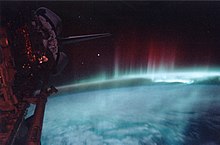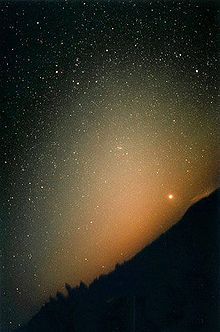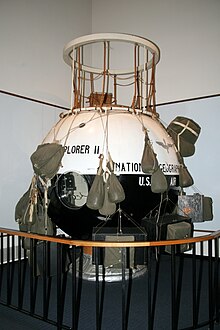太空

太空(粵拼:taai3 hung1),又有叫做外太空、宇宙空間、或者外層空間,指嘅係天體(包埋地球)之間嗰個好大好大嘅空間。太陽、月球、同埋八大行星冚唪唥都係喺太空入面飄嚟飄去嘅。太空好接近真空:宇宙大部份嘅空間都係空寥寥嘅星際空間,就連星系當中嘅空間都係以乜都冇嘅空間佔咗大半橛。佢當中啲嘢密度都好低:佢裏面有啲氣體,以等離子態嘅氫為主,呢啲氣體稀薄得好緊要,冇可能令人唞到氣;太空嗰度又有啲背景輻射(指太空度一啲來源不明嘅電磁輻射),佢哋估計係由大爆炸嗰度留落嚟嘅,令到太空叫做有些少能量喺度,但係太空嘅溫度平均仲係喺攝氏零下 268 度左右,凍到乜噉,差唔多去到絕對零度[1]。除咗噉,太空嗰度仲有啲流星、宇宙射線、同眼睇唔到嘅重力場等嘅嘢。
地球同太空之間冇乜嘢好清楚嘅分界線,由地表嗰度計起,大氣層愈高就愈稀薄,冇話會喺某個高度啲空氣會突然之間唔見嗮。為咗方便起見,喺高空 100 公里嘅卡門線(Kármán line)一般都喺航天等嘅領域嗰度俾人習慣性噉當做地球同外太空之間嘅分界線[2],而用卡門線做地球同太空分界呢個慣例喺國際法等嘅地方都會用到,包括咗好出名嘅喺 1967 年制定嘅《外太空條約》(Outer Space Treaty)-呢條條約講明太空冇任何一個主權國家可以霸嗮,所有國家都有權自由噉探索佢,而佢對「太空」呢個詞嘅定義就係用咗「卡門線以外嘅空間」[3]。
環境
[編輯]
物質
[編輯]太空係目前已知嘅環境入面最近完美真空(perfect vacuum)嘅。星系際空間(指星系之間嘅空間)幾乎係乜嘢都冇嘅-佢每立方米得嗰幾粒氫原子[4](相比之下,人類日常唞嘅空氣每立方米有大約1025 粒氧氣等嘅分子[5])。呢個噉空嘅空間喺實際上冇任何嘅摩擦力,令到恆星、行星、各種其他嘅天體、同埋太空船有得好自由噉喺佢哋嘅理想軌道嗰度運行。一架太空船喺太空嗰度熄咗個引擎都可以無止境噉飛到永遠(除非佢撞到啲乜)。
呢個噉空嘅環境仲令到好似光噉嘅電磁波可以飛到好遠嘅距離,而唔會俾啲嘢散射(scattering;指好似光呢類嘅波動因為佢哋嘅傳播媒介嘅影響而改變運行嘅方向)-一粒光子喺星際空間嘅平均自由徑(mean free path)係 1023 公里(相當於100億光年),即係話一粒光子喺太空嗰度平均要行嗰個距離先至會撞到啲嘢[6]。呢點令到好似哈勃太空望遠鏡噉嘅望遠鏡唔單止可以探測到好遠(幾百億光年)以外嘅光,而且科學家仲可以安心噉假設呢啲光大致上係跟住直線飛嘅,所以估起其他天體同地球嘅距離上嚟易好多。
太空入面嘅嘢之中淨係得好少部份係直接觀察得到嘅-據估計,太空裏面嘅嘢有成90%嘅係暗物質同埋暗能量,呢啲黑暗嘅嘢似乎唔會放任何輻射(包括可見光),所以啲太空科學家嘅望遠鏡幾勁都冇可能會直接睇到佢哋,但係呢啲嘢產生嘅重力會影響睇得到嘅天體,而透過觀察呢啲重力影響就有得估計暗物質同暗能量嘅分佈[7][8]。
温度
[編輯]外太空極之凍,温度好接近絕對零度。佢充滿咗一啲背景輻射,呢啲輻射有啲係由各個恆星(包括咗太陽)嗰度射出嚟嘅,而且喺宇宙起源嘅大爆炸嗰度亦都留咗啲宇宙微波背景輻射落嚟(所有熱嘅嘢都會放輻射)。目前太空嘅背景輻射嘅黑體温度大約係開氏3度左右。呢個温度相當於攝氏零下270度,華氏零下454度[9]。喺太空嗰度嘅氣體嘅温度一定起碼等於呢個數字,但係佢入面少部份嘅空間會熱好多,例如係太陽嘅日冕(指包住恆星嘅一浸極熱等離子體)可以去到成開氏120萬至260萬度[10]。

輻射
[編輯]太空嗰度有好多對生物有害嘅輻射,呢啲輻射主要係能量好高嘅次原子粒子(好似係質子同電子呢啲細粒過原子嘅粒子)。除咗好似係行星嘅大氣或者磁場,佢哋基本上喺太空度暢通無阻噉射嚟射去,每粒帶嘅能量由106到1020電子伏特不等[11]。呢柞高能量輻射足以傷害電子儀器同埋著住太空衣嘅人類[12]。根據去完太空返嚟嘅太空人講,太空聞落有噚好似燒燶嘢同埋金屬噉嘅除,而呢噚除仲會黐喺佢哋啲太空衣同儀器度[13]。
磁場
[編輯]太空嗰度仲有啲磁場喺度。地球有股磁場保護住佢-地核會產生磁場,啲高能量嘅粒子好多都係帶電荷嘅,帶電荷嘅嘢會俾磁場影響而改變郁嘅方向,而地球股磁場就啱啱好令到射向地球嘅高能量粒子會改變飛行方向撞唔到落地表,保護咗包括人類在內嘅地表生物。除咗地球之外,有好多天體都曉產生磁場。例如係螺旋星系(指螺旋形嘅星系)嘅恆星誕生過程就會產生一股大約 5 至 10 μ高斯(Gauss)嘅極弱磁場[14]。
生機
[編輯]太空嘅環境可以話係極之惡劣,唔啱生物生存。一個人類如果冇著太空衣就走入太空嘅話一定會死得好慘[15],但係有某啲生物有能力喺太空環境之下生存一段長嘅時間:喺2007年,就有科學家發現歐洲ESA BIOPAN設施嘅地衣可以喺太空環境生存到成10日(人類喺太空入面生存到嘅時間係以秒嚟計嘅)[16];某啲植物品種嘅種子喺太空度擺咗一年半仲發到芽[17];除咗噉,枯草桿菌(Bacillus subtilis)又試過喺模擬嘅火星環境嗰度生存到559日[18]。總括嚟講,好似人類噉嘅複雜生物喺太空嗰度生存唔到,但係好多簡單嘅生物-好似某啲植物品種同埋細菌-就得。
根據宇宙撒種說(Lithopanspermia hypothesis),一啲有生命嘅行星可能會因為地質活動等嘅原因將啲帶有簡單生物嘅岩石射出去太空嗰度,而呢啲岩石跟手會飛去其他行星,並且將生命散播到周圍都係。有太空科學家估話早期嘅太陽系就發生過啲噉嘅事,令到一啲好原始嘅生命體喺地球、火星、同金星之間傳嚟傳去[19]。
分區
[編輯]
地球空間
[編輯]地球空間係近地球嘅太空區域。地球空間包括咗大氣層嘅上層,好似係磁層(指地球磁場有影響力嘅區域)。呢個區域有好多人造嘅嘢:大量嘅人造衛星喺呢個俾人嗌做近地軌道(low Earth orbit)嘅區域嗰度運行,而佢哋產生嘅太空垃圾(好似係爛咗嘅衛星碎片)都係呢個區域度飄嚟飄去嘅[20]。呢個區域喺卡門線以上,喺定義上算係外太空嘅一部份,但係喺卡門線對上幾百公里之內嘅大氣密度都仲係唔低,高到可以對呢啲人造嘢做成阻力,所以喺近地軌道行嘅人造衛星吓吓隔幾日就要開吓引擎嚟維持軌道,而啲太空垃圾亦都會因為阻力而失速跌返落地表。
地球空間嘅磁層所霸嘅空間因為太陽風(太陽因為自己內部作用而射出嚟嘅高能量粒子)而唔係完美嘅橢球體-佢對住太陽嗰面因為俾太陽風嘅壓力撳住所以有些少撳扁咗。佢俾太陽風打到有條尾,而呢條尾仲可以伸到去差唔多相當於1,000個地球半徑噉長[21]。月球個個月梗有大約四日會行經呢條尾,而喺呢段期間月球表面會少咗好多太陽風[22]。
地球空間佈滿咗啲低密度嘅帶電荷粒子,佢哋同好多自然現象息息相關。呢啲粒子有時會俾太陽風暴(指太陽風喺某啲時候突然變勁)打中而郁並且產生電流;除咗噉,喺地磁風暴(geomagnetic storm)嗰陣,地球空間嘅地帶可以變到好唔穩定,而呢啲風暴會造成好強嘅電流。呢啲各種嘅電磁現象可以永久噉整壞人造衛星嘅電子儀器,干擾到電子通訊同埋全球定位系統,亦都可以對喺嗰啲區域做緊嘢嘅太空人做成危險。同時,佢哋仲會令到一啲帶電粒子相撞同以光嘅形式嚟釋放能量-引致高緯度地區嘅上空度產生極光嘅現象[23]。
地月空間
[編輯]地月空間就係指地球嘅大氣層同月球之間嘅區域。地球同月球之間嘅距離平均係384,403公里左右[24]。一般習慣上都會當呢個區域以外嘅太空空間係深空[25]。
行星際空間
[編輯]
行星際空間指太陽系嘅恆星-太陽-同佢柞行星(包括地球在內嘅八大行星)之間嘅空間。呢個空間有得一路延伸到去太陽圈(heliosphere;指以太陽嘅磁場同射出嚟嘅粒子做主導嘅空間)嘅盡頭嗰度[26]。佢係用太陽風嚟定義嘅-太陽係噉向外射啲太陽風粒子,令到佢周圍有一個延伸成幾十億公里長嘅「太陽大氣層」,而呢個區域亦都係太陽嘅影響力範圍,一出咗呢個區域太陽嘅影響力就會大跌。而除咗太陽之外,其他恆星都有各自嘅行星(喺1995年發現咗第一粒太陽系外行星),所以都有各自嘅行星際空間[27]。
太陽系嗰個行星際空間差唔多係完全真空,而喺呢個區域入面嘅平均自由徑大約係1個天文單位(指大約地球同太陽之間嘅距離)左右。呢個空間有些少宇宙射線,而呢啲射線包括咗離子化咗嘅原子核同埋唔同嘅次原子粒子。呢個區域大把太陽風,太陽風嘅密度平均係每立方厘米5到10粒質子,佢以秒速350到400公里向太陽嘅四周圍猛噉吹[28];除咗噉,呢個區域入面仲有啲氣體、等離子體、塵埃、流星、同埋少少有機分子等嘅濕碎嘢[29]。呢啲濕碎嘢會反射太陽射出嚟嘅光,有時夜晚嗰陣喺地表用肉眼都會望得到佢哋-即係所謂嘅黃道光現象[30]。
行星際空間有好多磁場。太陽同八大行星嘅大部份(包括地球、木星、土星、同水星等)都曉產生各自嘅磁場。各個行星嘅磁場都會因為太陽風嘅壓力而變形,並且喺粒行星後面形成一條好長嘅尾。呢啲行星磁場會改變佢周圍啲太陽風粒子嘅運行方向,並且保護佢哋所屬行星嘅表面唔會俾太陽風直接打擊。好似火星呢啲冇磁場嘅行星會受到太陽風嘅直擊。呢點除咗令到佢嘅表面唔啱生物生存之外,仲會令到佢個大氣層俾太陽風慢慢噉吹走,呢個亦都係火星個大氣層比地球嗰個薄噉多嘅主要原因[31]。

星際空間
[編輯]星際空間係指同一個星系入面啲恆星系之間嘅空間[32],而星際物質就係喺呢個空間入面嗰啲物質。星際物質入面有成大約70%左右嘅質量係單獨嘅氫原子,而淨低嘅就多數係氦,仲有小量嘅由恆星核合成(stellar nucleosynthesis)嗰度嚟嘅重原子-恆星內部嘅核聚變等嘅反應係透過將氫呢啲細粒原子撞埋一齊嚟產生能量(光同熱)同大粒原子嘅,呢啲大粒原子會以恆星風(stellar wind)等嘅形式俾佢哋所屬嘅恆星射出去太空嗰度,而且一粒超新星爆嗰陣佢入面又會有好多嘢飛出太空度。星際空間嘅物質密度可以好唔同:平均大約係每立方米106 粒粒子,但係凍啲嘅分子雲入面可以有每立方米108到1012粒粒子[33]。
星際空間有唔少種類嘅粒子存在,包括得0.1微米噉細嘅塵埃粒子[34]。喺呢啲空間度有啲分子雲-指一啲物質密度高些少嘅區域,而喺呢啲區域度嘅粒子可以有化學反應產生啲複雜啲嘅多原子嘅物質種類。帶有能量嘅宇宙射線會穿過又凍又密嘅分子雲,將嗰度嘅粒子(主要係氫同氦)離子化或者令到佢哋能量增加(噉嘅話佢哋就更加有機會會撞埋一齊做化學反應),甚至仲會產生含碳嘅有機物質分子[35]。
最近地球嘅星際空間區域係太陽100秒差距(1秒差距大約等如3.2616光年)之內嘅區域。呢個區域大致上同本地泡(Local Bubble)相等。「本地泡」係銀河系獵戶臂(Orion arm)當中一個密度零舍低嘅區域。佢四周圍有啲密嘅分子雲圍住,而佢入面有大約104到105粒恆星同埋一啲温度去到開氏7000度左右、半俓由0.5到5秒差距長嘅星際雲[36]。
星系際空間
[編輯]
星系際空間係指星系(一大堆俾萬有引力吸埋一齊嘅恆星系,包括咗太陽系身處嘅銀河系)之間嘅空間。對於星系嘅研究顯示宇宙入面有大約1/10嘅空間俾各種嘅星系霸住,而淨低落嚟嘅空間幾乎係完全空嘅。宇宙嘅密度分佈好明顯唔均勻,佢嘅物質密度由喺星系入面嘅非常高去到喺廣大嘅星系際空間嘅非常低,喺星系際空間度每立方米連1粒氫原子都未必有。
星系之間有啲稀薄嘅等離子體圍住[37]。呢啲等離子體俾人嗌做星系際介質(intergalactic medium),以俾啲嘢電離咗嘅氫為主,所以有數量大致上相等嘅電子同質子。佢哋似乎有纖維狀嘅結構[38],而且密度係宇宙平均嘅10到100倍,每立方米有10到100粒氫原子。
以地球嘅標準嚟睇,星系際介質嘅温度熱得好交關,當啲氣體由空洞走入去星系際介質嗰度,佢哋會加熱到去成開氏105到107度[39]-足以令到氫原子相撞撞到佢哋啲電子飛嗮出嚟變做等離子體。喺呢個温度嘅星系際介質叫做溫熱星系際介質(warm-hot intergalactic medium;簡稱「WHIM」)。根據電腦嘅模擬顯示,宇宙入面睇怕有超過一半嘅原子物質都係以呢種狀態存在嘅[40][41]。
太空探索
[編輯]
古代
[編輯]早喺史前時期人類經已有喺度諗天外面以外嘅世界。前350年嘅古希臘哲學家有討論好多有關哲學同宇宙嘅嘢,當中嘅阿里士多德(Aristotle)曾經提出「大自然最憎真空」(Horror vacui)嘅諗法,而呢個諗法係建基喺前5世紀希臘哲學家Parmenides嘅見解:Parmenides認為真空呢家嘢冇可能存在[42]。呢個觀點喺後尾嗰千幾年都普遍受到西人信服,一路去到成17世紀,法國哲學家笛卡兒(René Descartes)都仲喺度詏話太空入面唔係真空,而係有一啲睇唔到嘅物質喺度。
而喺東方,2世紀嘅東漢天文學家張衡又有曾經話空間係無止境嘅,而且延伸到去太陽同埋星星以外嘅地方-即係話嗰時嘅東方人(或者至少係中原嗰頭嘅人)已經對於「天以外嘅世界」係啲乜有些少基本概念。
廿世紀以嚟
[編輯]喺人類歷史嘅大部份時間,人類要探索太空多數都淨係有得用望遠鏡等嘅架生睇或者靠估。但係由20世紀開始,各種嘅航天科技開始發展得好快。喺1935年,美國嘅高高度氣球「探險家二號」(Explorer II)載住人飛到上去離地表22公里噉高[43]。打後喺1942年德國喺二戰嗰陣研發嘅V-2火箭爬升到去成離地表80公里嘅高空。而1957年嘅俄羅斯火箭帶住人造衛星史撥尼克1號飛咗上去離地表215到939公里嘅高度-超過咗卡門線[44]。第一次有人類上太空就係1961年嘅俄羅斯太空人加加林(Ю́рий Алексе́евич Гага́рин),佢搭住架太空船飛到上去超過卡門線嘅地方,跟手仲要安全噉返到落地球。後嚟美國嘅太空人三人組Frank Borman、Jim Lovell、同威廉‧安德斯(William Anders)就喺阿波羅8號上到去月球軌道-係第一次有人類可以脫離地球軌道-仲去到成離地球377,349公里嗰度噉遠[45]。
到咗21世紀,人類射火箭帶啲人同衛星上太空已經係家常便飯。喺近地軌道嗰度飛緊嘅衛星同太空垃圾多到數都數唔嗮。而且歐美地區仲開始咗探索人類搬屋去太空嘅可能性,並且射咗好多探測器去金星或者火星呢啲近地球嘅行星[46]。
太空法
[編輯]《外太空條約》(Outer Space Treaty)喺國際法嗰度提供咗世界各國應該點樣看待外太空嘅一套框架。佢定義咗乜嘢係「太空」同埋天體,並且講到明話世界嘅各國都有權自由噉探索太空,而冇任何一個國家有資格霸住太空嚟用。佢亦都唔俾人喺外大空嗰度用核武。呢個條約係喺1963年由聯合國大會通過,而跟手喺1967年由美國、英國、同蘇聯簽埋嘅。直至2008年,呢條條約一共有98國(包括中國)簽咗[47]。
睇埋
[編輯]
太空科學
[編輯]近人類嘅天體
[編輯]拎
[編輯]- Intergalactic Space, Natural History, Feb 1998
- Profits set to soar in outer space.
- Newscientist Space
- X PRIZE Foundation
- Newscientist Space
- space.com
攷
[編輯]- ↑ Chuss, D. T. (June 26, 2008), Cosmic Background Explorer, NASA Goddard Space Flight Center, archived from the original on May 9, 2013, retrieved 2013-04-27.
- ↑ "Where does space begin? – Aerospace Engineering, Aviation News, Salary, Jobs and Museums". Aerospace Engineering, Aviation News, Salary, Jobs and Museums. Archived from the original on 2015-11-17. Retrieved 2015-11-10.
- ↑ Treaty on Principles Governing the Activities of States in the Exploration and Use of Outer Space, including the Moon and Other Celestial Bodies
- ↑ Tadokoro, M. (1968), "A Study of the Local Group by Use of the Virial Theorem", Publications of the Astronomical Society of Japan, 20: 230, Bibcode:1968PASJ...20..230T. This source estimates a density of 7 × 10−29 g/cm3 for the Local Group. An atomic mass unit is 1.66 × 10−24 g, for roughly 40 atoms per cubic meter.
- ↑ Tyson, P. (January 2012), The Kinetic Atmosphere: Molecular Numbers (PDF), archived from the original (PDF) on 16 March 2014, retrieved 13 September 2013.
- ↑ Davies 1977, p. 93.
- ↑ Trimble, V. (1987), "Existence and nature of dark matter in the universe", Annual Review of Astronomy and Astrophysics, 25: 425–472, Bibcode:1987ARA&A..25..425T,
- ↑ Dark Energy, Dark Matter
- ↑ Fixsen, D. J. (December 2009), "The Temperature of the Cosmic Microwave Background", The Astrophysical Journal, 707 (2): 916–920,
- ↑ Withbroe, G. L. (February 1988), "The temperature structure, mass, and energy flow in the corona and inner solar wind", Astrophysical Journal, Part 1, 325: 442–467,
- ↑ Letessier-Selvon, A.; Stanev, T. (July 2011), "Ultrahigh energy cosmic rays", Reviews of Modern Physics, 83 (3): 907-942.
- ↑ Lide 1993, p. 11-217.
- ↑ Lizzie Schiffman (July 17, 2013), What Does Space Smell Like, Popular Science, archived from the original on February 24, 2014, retrieved February 19, 2014.
- ↑ Wielebinski, R.; Beck, R. (2010), "Cosmic Magnetic Fields − An Overview", in Block, David L.; Freeman, Kenneth C.; Puerari, Ivânio, Galaxies and their Masks: A Conference in Honour of K.C. Freeman, FRS, Springer Science & Business Media, pp. 67–82.
- ↑ Bolonkin, A, (2009), "Man in Outer Space Without a Special Space Suit", American Journal of Engineering and Applied Sciences, 2 (4): 573–579,
- ↑ Raggio, J.; et al. (May 2011), "Whole Lichen Thalli Survive Exposure to Space Conditions: Results of Lithopanspermia Experiment with Aspicilia fruticulosa", Astrobiology, 11 (4), pp. 281–292,
- ↑ Tepfer, D.; et al. (May 2012), "Survival of Plant Seeds, Their UV Screens, and nptII DNA for 18 Months Outside the International Space Station" (PDF), Astrobiology, 12 (5), pp. 517–528,
- ↑ Wassmann, M.; et al. (May 2012), "Survival of Spores of the UV-ResistantBacillus subtilis Strain MW01 After Exposure to Low-Earth Orbit and Simulated Martian Conditions: Data from the Space Experiment ADAPT on EXPOSE-E", Astrobiology, 12 (5), pp. 498–507,
- ↑ Nicholson, W. L. (April 2010), "Towards a General Theory of Lithopanspermia", Astrobiology Science Conference 2010, 1538, pp. 5272–528,
- ↑ Portree, D.; Loftus, J. (1999), Orbital Debris: A Chronology, NASA, p. 13, archived from the original (PDF) on 2000-09-01, retrieved 2012-05-05.
- ↑ Koskinen 2010, pp. 32, 42.
- ↑ Mendillo 2000, p. 275.
- ↑ "Geomagnetic Storms" (PDF), OECD/IFP Futures Project on "Future Global Shocks", CENTRA Technology, Inc., pp. 1–69, January 14, 2011, archived (PDF) from the original on March 14, 2012, retrieved 2012-04-07.
- ↑ Strickland, J. K. (October 1, 2012). "The cislunar gateway with no gate". The Space Review. Archived from the original on February 7, 2016. Retrieved 2016-02-10.
- ↑ Dickson 2010, p. 57.
- ↑ Abby Cessna (July 5, 2009), "Interplanetary space", Universe Today, archived from the original on March 19, 2015.
- ↑ Frisch et al. 2002, pp. 21-34.
- ↑ Papagiannis 1972, pp. 12–149.
- ↑ Flynn, G. J.; et al. (2003), "The Origin of Organic Matter in the Solar System: Evidence from the Interplanetary Dust Particles", in Norris, R.; Stootman, F., Bioastronomy 2002: Life Among the Stars, Proceedings of IAU Symposium #213, San Francisco: Astronomical Society of the Pacific, Bibcode:2004IAUS..213..275F.
- ↑ Leinert, C.; Grun, E. (1990), "Interplanetary Dust", Physics of the Inner Heliosphere I, Berlin, Germany: Springer-Verlag: 207, Bibcode:1990pihl.book..207L.
- ↑ Johnson, R. E. (August 1994), "Plasma-Induced Sputtering of an Atmosphere", Space Science Reviews, 69 (3–4): 215–253,
- ↑ Jia-Rui Cook (September 12, 2013), "How do we know when Voyager reaches interstellar space?", JPL News, 2013-278, archived from the original on September 15, 2013.
- ↑ Ferrière, K. M. (2001), "The interstellar environment of our galaxy", Reviews of Modern Physics, 73 (4): 1031.
- ↑ Rauchfuss 2008, pp. 72–81.
- ↑ Klemperer, W. (August 15, 2006), "Interstellar chemistry", Proceedings of the National Academy of Sciences of the United States of America, 103 (33): 12232–12234,
- ↑ Redfield, S. (September 2006), "The Local Interstellar Medium", New Horizons in Astronomy; Proceedings of the Conference– Held 16–18 October 2005 at The University of Texas, Austin, Texas, USA, Frank N. Bash Symposium ASP Conference Series, 352, p. 79,
- ↑ Jafelice, L. C.; Opher, R. (July 1992), "The origin of intergalactic magnetic fields due to extragalactic jets", Monthly Notices of the Royal Astronomical Society, Royal Astronomical Society, 257 (1): 135–151,
- ↑ Wadsley, J. W.; et al. (August 20, 2002), "The Universe in Hot Gas", Astronomy Picture of the Day, NASA, archived from the original on June 9, 2009, retrieved 2009-06-19.
- ↑ Gupta, A.; Galeazzi, M.; Ursino, E. (May 2010), "Detection and Characterization of the Warm-Hot Intergalactic Medium", Bulletin of the American Astronomical Society, 41: 908.
- ↑ Fang, T.; et al. (2010), "Confirmation of X-Ray Absorption by Warm-Hot Intergalactic Medium in the Sculptor Wall", The Astrophysical Journal, 714 (2): 1715.
- ↑ Bykov, A. M.; Paerels, F. B. S.; Petrosian, V. (February 2008), "Equilibration Processes in the Warm-Hot Intergalactic Medium", Space Science Reviews, 134 (1–4): 141-153.
- ↑ Grant 1981, p. 10.
- ↑ Pfotzer, G. (June 1972), "History of the Use of Balloons in Scientific Experiments", Space Science Reviews, 13 (2): 199–242
- ↑ O'Leary 2009, pp. 209–224.
- ↑ Orloff 2001.
- ↑ Landgraf, M.; et al. (February 2001), "IRSI/Darwin: peering through the interplanetary dust cloud", ESA Bulletin, (105): 60-63.
- ↑ Treaty on Principles Governing the Activities of States in the Exploration and Use of Outer Space, including the Moon and Other Celestial Bodies, United Nations Office for Outer Space Affairs, January 1, 2008, archived from the original on February 22, 2011, retrieved 2009-12-30.
文獻
[編輯]- Barbieri, C. (2006), Fundamentals of Astronomy, CRC Press, p. 253, ISBN 0750308869
{{citation}}: Invalid|ref=harv(help) - Billings, Charles E. (1973), "Barometric Pressure", 出自 Parker, James F.; West, Vita R. (編), Bioastronautics Data Book,第3006卷 (第2版), NASA, Bibcode:1973NASSP3006.....P, NASA SP-3006
{{citation}}: Invalid|ref=harv(help) - Bolonkin, Alexander (2010), Non-Rocket Space Launch and Flight, Elsevier, ISBN 0080458750
{{citation}}: Invalid|ref=harv(help) - Borowitz, Sidney; Beiser, Arthur (1971), Essentials of physics: a text for students of science and engineering, Addison-Wesley series in physics (第2版), Addison-Wesley Publishing Company
{{citation}}: Invalid|ref=harv(help) Note: this source gives a value of 2.7 × 1025 molecules per cubic meter. - Cajori, Florian (1917), A history of physics in its elementary branches: including the evolution of physical laboratories, New York: The Macmillan Company
{{citation}}: Invalid|ref=harv(help) - Chamberlain, Joseph Wyan (1978), Theory of planetary atmospheres: an introduction to their physics and chemistry, International geophysics series,第22卷, Academic Press, ISBN 0-12-167250-6
{{citation}}: Invalid|ref=harv(help) - Collins, Martin J. (2007), "Mariner 2 Mock-up", After Sputnik: 50 years of the Space Age, HarperCollins, ISBN 0-06-089781-3
{{citation}}: Invalid|ref=harv(help) - Davis, Jeffrey R.; Johnson, Robert; Stepanek, Jan (2008), Fundamentals of Aerospace Medicine (第4版), Lippincott Williams & Wilkins, ISBN 0-7817-7466-7
{{citation}}: Invalid|ref=harv(help) - Davies, P. C. W. (1977), The physics of time asymmetry, University of California Press, ISBN 0-520-03247-0
{{citation}}: Invalid|ref=harv(help) Note: a light year is about 1013 km. - Dickson, Paul (2010), A Dictionary of the Space Age, New Series in NASA History, JHU Press, ISBN 0801895049.
{{citation}}: Invalid|ref=harv(help) - Eckert, Michael (2006), The dawn of fluid dynamics: a discipline between science and technology, Wiley-VCH, ISBN 3-527-40513-5
{{citation}}: Invalid|ref=harv(help) - Ellery, Alex (2000), An introduction to space robotics, Springer-Praxis books in astronomy and space sciences, Springer, ISBN 1-85233-164-X
{{citation}}: Invalid|ref=harv(help) - Freedman, Roger A.; Kaufmann, William J. (2005), Universe (第seventh版), New York: W. H. Freeman and Company, ISBN 0-7167-8694-X
{{citation}}: Invalid|ref=harv(help) - Fichtner, Horst; Liu, W. William (2011), "Advances in Coordinated Sun-Earth System Science Through Interdisciplinary Initiatives and International Programs", 寫喺Sopron, Hungary, 出自 Miralles, M.P.; Almeida, J. Sánchez (編), The Sun, the Solar Wind, and the Heliosphere, IAGA Special Sopron Book Series,第4卷, Berlin: Springer, p. 341, Bibcode:2011sswh.book..341F, doi:10.1007/978-90-481-9787-3_24, ISBN 978-90-481-9786-6
{{citation}}: Invalid|ref=harv(help) - Frisch, Priscilla C.; Müller, Hans R.; Zank, Gary P.; Lopate, C. (May 6–9, 2002), "Galactic environment of the Sun and stars: interstellar and interplanetary material", 出自 Livio, Mario; Reid, I. Neill; Sparks, William B. (編), Astrophysics of life. Proceedings of the Space Telescope Science Institute Symposium, Space Telescope Science Institute symposium series,第16卷, Baltimore, MD, USA: Cambridge University Press, p. 21, Bibcode:2005asli.symp...21F, ISBN 0-521-82490-7
{{citation}}: Invalid|ref=harv(help) - Gatti, Hilary (2002), Giordano Bruno and Renaissance science, Cornell University Press, ISBN 0-8014-8785-4
{{citation}}: Invalid|ref=harv(help) - Genz, Henning (2001), Nothingness: the science of empty space, Da Capo Press, ISBN 0-7382-0610-5
{{citation}}: Invalid|ref=harv(help) - Ghosh, S. N. (2000), Atmospheric Science and Environment, Allied Publishers, ISBN 8177640437
{{citation}}: Invalid|ref=harv(help) - Grant, Edward (1981), Much ado about nothing: theories of space and vacuum from the Middle Ages to the scientific revolution, The Cambridge history of science series, Cambridge University Press, ISBN 0-521-22983-9
{{citation}}: Invalid|ref=harv(help) - Hardesty, Von; Eisman, Gene; Krushchev, Sergei (2008), Epic Rivalry: The Inside Story of the Soviet and American Space Race, National Geographic Books, pp. 89–90, ISBN 1-4262-0321-7
{{citation}}: Invalid|ref=harv(help) - Hariharan, P. (2003), Optical interferometry (第2版), Academic Press, ISBN 0-12-311630-9
{{citation}}: Invalid|ref=harv(help) - Harris, Philip Robert (2008), Space enterprise: living and working offworld in the 21st century, Springer Praxis Books / Space Exploration Series, Springer, ISBN 0-387-77639-7
{{citation}}: Invalid|ref=harv(help) - Harrison, Albert A. (2002), Spacefaring: The Human Dimension, University of California Press, ISBN 0-520-23677-7
{{citation}}: Invalid|ref=harv(help) - Holton, Gerald James; Brush, Stephen G. (2001), "Physics, the human adventure: from Copernicus to Einstein and beyond", Physics Today (第3版), Rutgers University Press, 54 (10): 69, Bibcode:2001PhT....54j..69H, doi:10.1063/1.1420555, ISBN 0-8135-2908-5
{{citation}}: Invalid|ref=harv(help) - Kelly, Suzanne (1965), The de muno of William Gilbert, Amsterdam: Menno Hertzberger & Co.
{{citation}}: Invalid|ref=harv(help) - Koskinen, Hannu (2010), Physics of Space Storms: From the Surface of the Sun to the Earth, Environmental Sciences Series, Springer, ISBN 3-642-00310-9
- Lang, Kenneth R. (1999), Astrophysical formulae: Radiation, gas processes, and high energy astrophysics, Astronomy and astrophysics library (第3版), Birkhäuser, ISBN 3-540-29692-1
{{citation}}: Invalid|ref=harv(help) - Lide, David R. (1993), CRC handbook of chemistry and physics (第74版), CRC Press, ISBN 0-8493-0595-0
{{citation}}: Invalid|ref=harv(help) - Maor, Eli (1991), To infinity and beyond: a cultural history of the infinite, Princeton paperbacks, ISBN 0-691-02511-8
{{citation}}: Invalid|ref=harv(help) - Mendillo, Michael (November 8–10, 2000), "The atmosphere of the moon", 出自 Barbieri, Cesare; Rampazzi, Francesca (編), Earth-Moon Relationships, Padova, Italy at the Accademia Galileiana Di Scienze Lettere Ed Arti: Springer, p. 275, ISBN 0-7923-7089-9
{{citation}}: Invalid|ref=harv(help) - Needham, Joseph; Ronan, Colin (1985), The Shorter Science and Civilisation in China, Shorter Science and Civilisation in China,第2卷, Cambridge University Press, ISBN 0-521-31536-0
{{citation}}: Invalid|ref=harv(help) - O'Leary, Beth Laura (2009), Darrin, Ann Garrison (編), Handbook of space engineering, archaeology, and heritage, Advances in engineering, CRC Press, ISBN 1-4200-8431-3
{{citation}}: Invalid|ref=harv(help) - Olenick, Richard P.; Apostol, Tom M.; Goodstein, David L. (1986), Beyond the mechanical universe: from electricity to modern physics, Cambridge University Press, ISBN 0-521-30430-X
{{citation}}: Invalid|ref=harv(help) - Orloff, Richard W. (2001), Apollo by the Numbers: A Statistical Reference, NASA, ISBN 0-16-050631-X, 喺2008-01-28搵到
{{citation}}: Invalid|ref=harv(help) - Papagiannis, Michael D. (1972), Space Physics and Space Astronomy, Taylor & Francis, ISBN 0-677-04000-8
{{citation}}: Invalid|ref=harv(help) - Piantadosi, Claude A. (2003), The Biology of Human Survival: Life and Death in Extreme Environments, Oxford University Press, ISBN 0199748071
{{citation}}: Invalid|ref=harv(help) - Porter, Roy; Park, Katharine; Daston, Lorraine (2006), "The Cambridge History of Science: Early modern science", Early Modern Science, Cambridge University Press,第3卷, p. 27, ISBN 0-521-57244-4
{{citation}}: Invalid|ref=harv(help) - Prialnik, Dina (2000), An Introduction to the Theory of Stellar Structure and Evolution, Cambridge University Press, ISBN 052165937X, 喺2015-03-26搵到
{{citation}}: Invalid|ref=harv(help) - Razani, Mohammad (2012), Information Communication and Space Technology, CRC Press, ISBN 1439841632
{{citation}}: Invalid|ref=harv(help) - Rauchfuss, Horst (2008), Chemical Evolution and the Origin of Life, Translated by T. N. Mitchell, Springer, ISBN 3-540-78822-0
{{citation}}: Invalid|ref=harv(help) - Schrijver, Carolus J.; Siscoe, George L. (2010), Heliophysics: Evolving Solar Activity and the Climates of Space and Earth, Cambridge University Press, ISBN 0-521-11294-X
{{citation}}: Invalid|ref=harv(help) - Silk, Joseph (2000), The Big Bang (第3版), Macmillan, ISBN 0-8050-7256-X
{{citation}}: Invalid|ref=harv(help) - Sparke, Linda S.; Gallagher, John S. (2007), Galaxies in the Universe: An Introduction (第2版), Cambridge University Press, ISBN 978-0-521-85593-8
{{citation}}: Invalid|ref=harv(help) - Spitzer, Lyman, Jr. (1978), Physical Processes in the Interstellar Medium, Wiley Classics Library, ISBN 0471293350
{{citation}}: Invalid|ref=harv(help) - Stuart Wortley, Emmeline Charlotte E. (1841), The maiden of Moscow, a poem, How and Parsons, Canto X, section XIV, lines 14–15,
All Earth in madness moved,—o'erthrown, / To outer space—driven—racked—undone!
{{citation}}: Invalid|ref=harv(help) - Thagard, Paul (1992), Conceptual revolutions, Princeton University Press, ISBN 0-691-02490-1
{{citation}}: Invalid|ref=harv(help) - Tassoul, Jean Louis; Tassoul, Monique (2004), A concise history of solar and stellar physics, Princeton University Press, ISBN 0-691-11711-X
{{citation}}: Invalid|ref=harv(help) - Tyson, Neil deGrasse; Goldsmith, Donald (2004), Origins: fourteen billion years of cosmic evolution, W. W. Norton & Company, pp. 114–115, ISBN 0-393-05992-8
{{citation}}: Invalid|ref=harv(help) - Von Humboldt, Alexander (1845), Cosmos: a survey of the general physical history of the Universe, New York: Harper & Brothers Publishers
{{citation}}: Invalid|ref=harv(help) - Webb, Stephen (1999), Measuring the universe: the cosmological distance ladder, Springer, ISBN 1-85233-106-2
{{citation}}: Invalid|ref=harv(help) - Wong, Wilson; Fergusson, James Gordon (2010), Military space power: a guide to the issues, Contemporary military, strategic, and security issues, ABC-CLIO, ISBN 0-313-35680-7
{{citation}}: Invalid|ref=harv(help) - Wszolek, Bogdan (2013), "Is there Matter in Voids?", 出自 Arp, H. C.; Keys, C. R.; Rudnicki, K. (編), Progress in New Cosmologies: Beyond the Big Bang, Springer Science & Business Media, p. 67, ISBN 1489912258
{{citation}}: Invalid|ref=harv(help)
